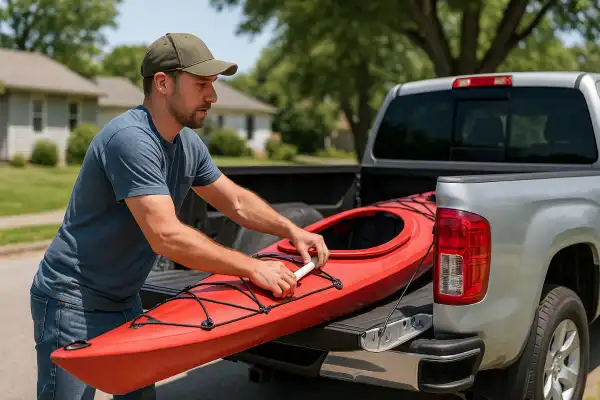How do you pack a kayak for camping without turning your graceful vessel into an unstable, gear-laden barge? This question keeps many paddlers awake the night before their first multi-day trip, and rightfully so. The difference between a well-packed kayak and a haphazardly loaded one can mean the distinction between smooth paddling and constant course corrections, between dry gear and soggy sleeping bags.
During my early guiding days in the Boundary Waters, I watched countless eager campers struggle with this exact challenge. One particular group arrived with everything stuffed into two massive dry bags—their kayak looked like a floating garage sale and handled about as well as you’d expect. That experience taught me that successful kayak camping starts long before you push off from shore.
How do you pack a kayak for camping?
Pack your kayak by distributing weight low and along the centerline, keeping heavy items like food and water close to the cockpit, and using multiple smaller dry bags (5-20 liters) rather than large ones to optimize space and weight distribution. The goal is creating a balanced, stable platform that responds predictably to your paddle strokes while keeping essential gear accessible and protected.

Weight distribution fundamentals
Proper weight distribution improves your kayak’s overall stability by keeping the center of gravity low and centered. Think of your loaded kayak as a seesaw that needs to remain level both front-to-back and side-to-side. Heavy items like water, food, and fuel belong closest to your center of gravity—typically between your legs or just behind the rear bulkhead.
Trim refers to your boat’s back-to-front balance, and a well-trimmed kayak lies flat in the water from front to back. This matters because kayaks act like weather vanes in wind and current—if one end sits higher, it will catch more wind and push you off course. Pack while your boat is in the water whenever possible to check proper trim, keeping in mind that your body weight will also affect the tilt.
Strategic dry bag selection and organization
Stay away from dry bags larger than 20 liters, as they make packing sea kayak hatches much more difficult and may be impossible to fit. Multiple smaller bags (5-10 liters) optimize weight distribution and work better with spatial constraints. Use dry bags small enough to fit through your hatch openings—it’s much easier to load and balance weight with many small bags than a few large ones.
Color-coding your dry bags eliminates the frustration of digging through identical containers. A brightly-colored dry bag is particularly useful for your first aid kit, repair kit, or rescue kit, making it easily recognizable and quick to find. Consider using compression sacks for clothing and sleeping gear to maximize space efficiency.
Always assume your gear will get wet—the most waterproof hatch covers leak, dry bags eventually wear out, and boats roll and fill with water. Wrap critical items like sleeping bags and stoves in extra plastic bags for additional protection, then bury them deep in reliable waterproof dry bags.
Packing sequence and accessibility
Pack equipment you’ll need during the day (like lunch or extra clothing) near the top of your load, and less crucial gear (like your tent) near the bottom. Pack frequently accessed items toward the top layers or in external pouches to avoid constantly unpacking gear or digging around for essentials like snacks, sunscreen, or navigation tools.
Start with your heaviest, least-needed items in the deepest compartments. Food for later in the trip, your tent, and extra clothing form the foundation of your load. Heavy items like food, water, and beer should go as close to the cockpit as possible—usually just behind the rear bulkhead—so that as their weights are reduced through the trip, they have little effect on trim and balance.
Cockpit and deck storage
The cockpit is the biggest storage hatch in your kayak, with room for dry bags behind the seat and long rigid items alongside the seat. A sleeping pad, sleeping bag, or dry bag with clothing can be placed between your legs—this is comfortable and gives your legs something to brace against, improving your paddling technique.
Water is the densest and heaviest gear you’ll bring, so store water bladders as close to the kayak’s center as possible, usually between your legs, where they won’t shift or roll. Don’t underestimate the amount of water you’ll need—paddling is thirsty work, and water weight can quickly push you toward your kayak’s load capacity.
Safety equipment positioning
Your first-aid kit needs to be close at hand—store it under your seat or in a nearby seat pack. Emergency paddles must be immediately accessible yet secure enough that they aren’t dislocated in rough conditions or capsizes. Most kayakers secure spare paddles in deck rigging or inside the cockpit, flush against one side.
Flares, whistles, and other signaling devices should be carried on your person at all times—most PFDs have small chest pockets perfect for this purpose. Navigation tools like maps and compasses should be stored in waterproof cases, either attached to deck rigging or kept in accessible pockets.
Load testing and final adjustments
Do a test run at home by placing your kayak on a flat surface and loading all your gear as if preparing for the actual trip. This allows you to assess weight distribution and balance visually before reaching the water’s edge. Pack all water-sensitive gear in dry bags no matter what climate you’re paddling in.
Most expedition kayaks accommodate significant weight, but overloading can cause your kayak to sit lower in the water, leading to performance and stability issues and increasing capsize likelihood. Every boat has a maximum weight capacity that you shouldn’t exceed—think like a backpacker and simplify your gear selection, leaving behind anything extraneous.
Remember that gear expands throughout your trip. What packs down tight the first day may steadily expand as the trip progresses—those neatly folded clothes may not compress as well by day five. Plan accordingly and resist the urge to stuff every available space on day one.
Conclusion
Last summer, I guided a family on their first overnight trip to a remote island in Georgian Bay. The father had meticulously followed a systematic packing approach—everything balanced, accessible, and secure. Even when we encountered unexpected afternoon winds, his kayak tracked beautifully while others struggled with poorly distributed loads. That evening, while setting up camp, he mentioned how following a proven packing system had transformed what seemed overwhelming into an organized, enjoyable process. Once you’ve found a strategy that works, there’s nothing too tricky about packing a kayak for camping.
